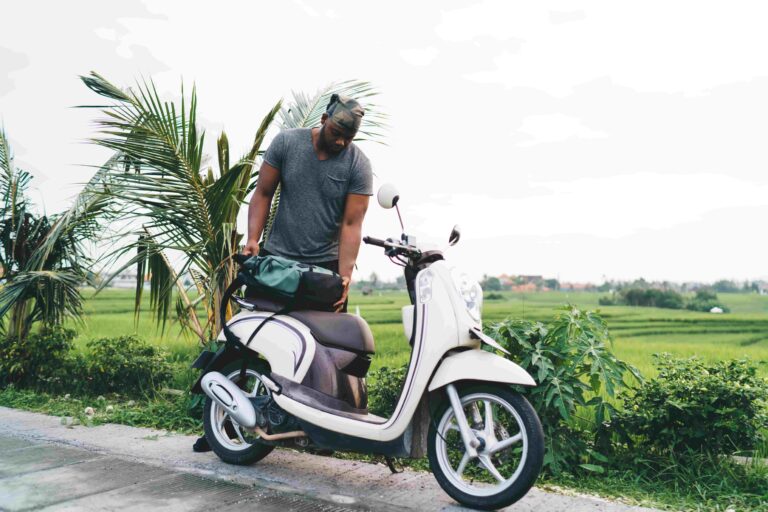If you had come to Bali just a decade ago, you’d have found the roads were very different than they are today. Many tourists say that the biggest downside of visiting this lovely island now is the slow-moving traffic.
Well, we can’t fix that problem by ourselves but we can help you make the most of your time here and offer some short-term strategies for coping with the heavy traffic until it’s fixed at a higher level.
Our guide to the Balinese roads will help you understand what’s going on here and what part tourists can play in dealing with things.
The Current State Of Play
People come to Bali for the stunning beaches, art markets, rice fields and friendly local people. Then, they are forced to take a taxi down narrow streets at rush hour and suddenly the tourists aren’t having such a great time of things.
The state of play here on the island of Bali when it comes to traffic could certainly be better, though as anyone who has visited Jakarta could tell you, it could be far worse too.
Regular Traffic Jams
One of the real issues facing Bali is that most of the development on the island has occurred around the best beaches.
There’s no point in building resorts, beach clubs, etc. in places where people don’t want to be on the beach, is there?
So, beginning with Kuta Beach and then moving into Legian and Seminyak and, most recently, Canggu and Ubud (which is not on the beach but in the mountains), there has been a huge amount of development.
However, while the local infrastructure was being built, Bali wasn’t building much in the way of new roads. In fact, all the resorts, etc. were being built around the existing narrow roads.
As visitors increased, so did the number of cars and other types of vehicle such as trucks and scooters, and thus, tourism led to heavy traffic in these places.
Much of the trip will be spent gazing out the window at locals and holidaymakers alike moving at a snail’s pace down the road.
Now, things aren’t as bad in Bali, yet, as they can be in different parts of Indonesia, in Jakarta, a 1 mile trip can take hours as the traffic barely moves in parts of that city but for visitors to Bali, it’s quite bad enough.
Dreadful Driving Standards
It’s not just the volume of cars and bikes that you have to worry about during the trip to any given destination though. The driving standards in this country are somewhat informal, to say the least.
In fact, driving in Bali doesn’t really have much in the way of rules and even if it did, it quickly becomes apparent that most expats and locals aren’t following those rules.
We regularly try to discourage people from taking a scooter in Bali, that’s not because we’re snobs or that we think you should be paying a premium for transport, it’s because the driving standards make it dangerous to be on the road.
If you have an accident inside a car or a van, it will usually be moving slowly enough that, as long as you’re wearing a seatbelt, the worst thing that happens is you bump into an airbag.
But if you come off a scooter, then accidents can be far, far more damaging. There’s nothing worse than visiting Bali to end up stuck in a hospital bed and facing a large bill for treatment.
Fears For Tourist Hotspots
This state of affairs is, of course, a real problem. The locals in Bali are completely dependent on tourism. 80% of the economy here on the island depends on tourist dollars.
The art markets, hotels, restaurants, shopping centres, etc. depend on constant arrivals at the airport. While Indonesia suffered through the pandemic lockdowns, Bali was badly hurt as it cut off arrivals from the outside world.
This tiny island is currently one of the most popular places to visit in the world and that’s a good thing, Bali is truly beautiful.
But if there comes a time when Bali starts to resemble other parts of Indonesia where a taxi journey costs a fortune to go short distances because there is no flow of vehicles on the streets, then people are going to start to choose to go elsewhere.
This isn’t speculation, a recent article in the local newspaper, The Bali Sun, recognizes this and the local government and tourism board are starting to come up with plans to deal with the issues on Bali’s streets.
Coping With The Traffic In Bali
Stay Where You Want To Be In Bali
The best way to avoid spending large parts of your week on the streets of Bali is to stay where you want to be.
Kuta, for example, may be full of drivers at certain times of day, but if your hotel is there, you can get where you want to be by walking and there are plenty of local restaurants, shopping centres, etc. for you to enjoy.
Walking is good for you, it’s good for the environment and it may help to preserve Bali in the process.
Go The Long Way Round
This may sound crazy but most cars here on the island of Bali tend to pursue, for the most part, their journeys based on the principle that the shortest distance between two points is a straight line.
That means, if you are prepared to play with Google Maps and look at a more round-about route to your destination, there will be far fewer cars, etc. on that route and thus, it will be much easier for you to get where you’re going.
Sure, this will add on a few minutes, but jams are going to do that anyway, at least if you go an indirect route, you will enjoy the feeling of moving and see some more of this lovely part of Indonesia on the way.
From a safety perspective on these roads, the best way to get to your destination in one piece is to use the services of a local driver and rent a car with a driver.
They can also drop you off where you want to be before they go to look for parking.
This isn’t very expensive (as it would be at home) and it’s very convenient. If you don’t arrange this before you come to Bali, talk to your hotel concierge, they can help arrange it for you.
Cars Vs Motorbikes
The local road culture is very much scooter-obsessed, scooters are smaller and cheaper, but as we’ve already noted – they’re nowhere near as safe.
We’d avoid scooters wherever possible.
Ride-Share Apps
Ride-share apps such as Grab and Go-Jek have really taken off and can have a positive impact on road culture by reducing the overall number of vehicles on the road as, in effect, one vehicle is used by many people.
Food Delivery Services
You can also use these services to order food, this won’t improve the situation on the road but it does mean you won’t have to spend hours getting to a restaurant, either.
Future Solutions To Traffic In Bali
Better Policing
This idea is taking off across Indonesia. Roads will get safer if they have better policing. Bali is already examining ways to ensure that there are enough police on the roads.
We just hope that they will also tackle the issue of looking the other way in exchange for a cash consideration, otherwise, it will just mean richer police rather than better roads.
Tourism Taxes?
This is also underway with a tax to be collected from each visitor to the island.
While, in theory, this tax could be allocated to road improvement schemes, we’ve enough experience watching governments around the world, not just here in Indonesia, to know that each new revenue stream has a hundred potential applications.
Number Plate Schemes? Different Driving Days?
This part of Indonesia could always consider following Singapore and reducing the number of cars and scooters on the streets by holding a “number plate lottery”.
The trouble is that this would heavily disadvantage the poorest people on the island and might be entirely ignored if policing doesn’t improve.
Some places have introduced a system by which a car can only be on the road for half the week – Mon, Wed, Fri, Sun or Tue, Thu, Sat, Sun.
We’re not sure how this would be enforced and again, it seems to substantially hurt the poorest people in Bali.
FAQs
What Time Is Traffic Worst In Bali? What Time Is Peak Hour In Bali?
There are two times of day when things get bad on the roads here, 6-8 a.m. when everyone is going to work and then again between 5 and 7 p.m. when everyone is going home again.
However, in tourist hotspots, there is a second “peak period” of 8-10 a.m. when everyone is starting to hit the road for day trips, and then again from 4-7 p.m. when they return and/or start heading out for evening activities.
There can also be a third peak as the sunsets and people start to head out of the beach areas.
Why Is There So Much Traffic In Bali?
There has been a huge investment in infrastructure in Bali but this hasn’t been matched with an investment in road networks.
While the population of Bali is increasing, that’s not been too dramatic, but the tourist numbers have been going through the roof.
Where once, Bali could expect 5-6 million visitors a year, it can now see 15 million or more!
Is Bali Crowded Now?
No. Bali is not a crowded island. In fact, if you visit about 80% of Bali it’s not very busy at all but if you head to Kuta and the other beach towns, you could be forgiven for thinking this must be one of the busiest places anywhere.
The more hotels there are in a spot (and in Kuta, there are a lot of hotels) the more trucks, cars, drivers, etc. you’re going to find.
Can I Avoid The Traffic Congestion In Bali?
You can’t avoid congestion completely in Bali but you can improve your chances of getting around with less frustration by staying local to where you want to be, using a local driver and learning to wait for the less busy parts of the day to see new places.
Final Thoughts On Traffic, Bali
Bali, Indonesia is one of the most beautiful places in the world and it sees a lot of people arriving each year to enjoy the local culture, food and incredible beaches.
This has led to a boom in the number of vehicles on Balinese roads. This problem is being tackled at a high level but for now, you can use our guide to reduce the chances of injury and frustration when you travel on the island.
One thing we can tell you is that, we don’t let the roads here stop us from loving being in Bali.












